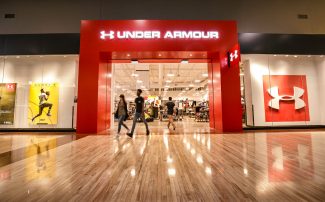Sponsored by Nedap
After establishing a new standard for electronic article surveillance (EAS) technology for its North American stores, Under Armour does have one lingering regret. “I could kick myself for not discovering this solution sooner,” said Sean Donnelly, director of global retail asset protection and investigations for the activewear giant.
Donnelly came to Under Armour six years ago and is responsible for safety and security at more than 250 stores; a number that could double by 2020 as the company undergoes rapid expansion. Upon his arrival, Under Armour stores had a solid EAS foundation in place. However, over time Donnelly began to wonder if the level of service, system accuracy, and price they were paying was truly best-in-class. Additionally, there was a desire to explore new technology in search of better results. “We consider innovation part of our brand’s DNA, which is also true for our asset protection department, and this feeds our desire to constantly innovate in a way that creates greater efficiencies from our team,” Donnelly explained.
So when members of his asset protection (AP) team relayed information about an RFID-capable EAS system offered by Nedap, he was intrigued. Donnelly was also lured by Nedap’s !D Top, which is a ceiling-mounted EAS/RFID reader that replaces the pedestals normally installed at store exits. While Under Armour is preparing to enable their stores with RFID capability for the future, they are not ready to fully leverage RFID for loss prevention and inventory control just yet. Donnelly liked the idea of Nedap’s solution, which can be utilized as a standalone RFID-capable EAS system today and be easily integrated into a total RFID merchandise tracking solution at a later date.
But switching to a new theft prevention technology would be no small project and had major implications. Therefore the AP team had to do their due diligence. “You always want to see that someone else is using the technology, and learn how it performs. We needed to understand Nedap’s reputation as well,” advised Donnelly. Feedback was resoundingly positive, with the team not only learning Nedap’s solution was popular in the European market, but that the company had a solid reputation for being collaborative.
Armed with positive results from their due diligence campaign, Under Armour decided it was time to initiate a test of the technology at a store in Ontario, CA. Nedap’s !D Top overhead reader was installed as a theft prevention solution at the store’s entrance. “The accuracy was incredible,” said Donnelly. “The intelligence of the system is such that it filtered out our competitors’ tags, which can cause traditional devices to alarm mistakenly. The other positive piece was that the cost for us was considerably less than Nedap’s competitors.”
However, while the system performed impressively, it still needed to win over store designers at the corporate level.
One of the most enduring complaints about aggressive loss prevention strategies is they can run counter to marketing and sales efforts. Whether it’s uniformed LP agents or devices that restrict customer access to products, retail executives are sensitive to any measure that may potentially degrade the customers’ experience. But when Nedap’s ceiling-mounted !D Top reader was put to the design test, it had no trouble passing.
“The previous EAS device was the size of a surfboard, however, the !D Top is about the size of a laptop computer,” explained Donnelly. “The store design team at corporate was absolutely ecstatic over the aesthetics of the !D Top. Something so small mounted ten feet high was just perfect.” It was so small, however, that it was initially a cause of Donnelly’s skepticism. “Honestly, it seemed too small to get the job done. That was my initial take,” he said. “But I was quickly proved wrong.”
Overall, the project has reflected positively on Under Armour’s AP department. “It was a big win. We were bringing the retail group a solution that was more accurate and more pleasing to the eye—and at a lower cost,” he said. “So at that point, adopting the Nedap solution as our North American standard was a no-brainer.” As of this year, all new and remodeled Under Armour stores use Nedap’s solutions for their EAS initiatives.
In the first eight months, the results have been exactly what Under Armour hoped for, according to Donnelly. “The collaboration with Nedap, both directly and through the integrator, has been phenomenal,” he added. “We’re now having conversations with Nedap about some sensor tagging needs and things that we could use in the future. Having that type of partnership is a tremendous benefit.”
The success is also why Donnelly now wishes he had been more aggressive in seeking out the opportunity for a more advanced solution—a mistake he advises his industry peers not to make. “I kicked myself for not actively looking earlier, and for not challenging my team to be looking,” said Donnelly. “My advice to other AP leaders is to not write things off by thinking that something looks too good to be true. Be open to challenging the status quo and willing to put new solutions to the test. We learned that openness pays big dividends, and it’s an important part of servicing any rapidly growing business that prides itself on innovation.”
For more information about Nedap’s solutions, visit www.nedapretail-americas.com/.



